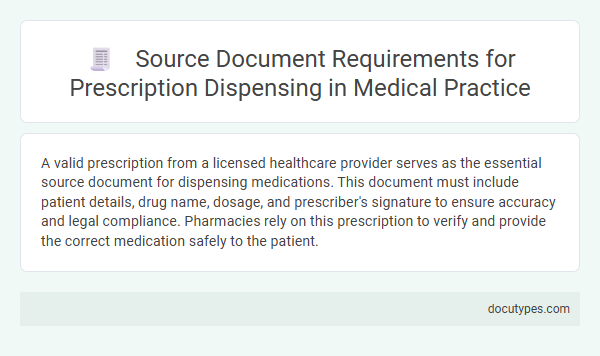A valid prescription from a licensed healthcare provider serves as the essential source document for dispensing medications. This document must include patient details, drug name, dosage, and prescriber's signature to ensure accuracy and legal compliance. Pharmacies rely on this prescription to verify and provide the correct medication safely to the patient.
Introduction to Source Document Requirements
Source documents are essential for accurate prescription dispensing and ensure compliance with medical and legal standards. These documents primarily include the original prescription issued by a licensed healthcare provider. Proper sourcing guarantees patient safety, prevents medication errors, and facilitates efficient pharmacy operations.
Importance of Accurate Documentation in Prescription Dispensing
| Source Document Required | Prescription form or electronic prescription (e-prescription) |
|---|---|
| Essential Details | Patient name, date of birth, medication name, dosage, frequency, prescriber's signature, date issued |
| Role in Prescription Dispensing | Acts as legal authorization for dispensing medication |
| Importance of Accurate Documentation | Prevents medication errors, ensures patient safety, facilitates pharmacy audits, supports continuity of care |
| Your Responsibility | Verify accuracy and completeness of the source document before dispensing |
| Consequences of Inaccurate Documentation | Risk of incorrect medication delivery, potential adverse drug reactions, legal liabilities, compromised patient trust |
Legal and Regulatory Frameworks Governing Source Documents
The source document required for prescription dispensing is primarily the original prescription issued by a licensed healthcare provider. This legal document serves as the foundation for verifying patient information and medication details before dispensing.
Legal and regulatory frameworks mandate that prescriptions must comply with specific standards, including prescriber identification, patient details, drug name, dosage, and directions for use. Regulatory bodies such as the FDA and DEA in the United States enforce stringent rules to prevent prescription fraud and abuse. Pharmacies must retain source documents for a defined period to ensure audit compliance and support pharmacovigilance activities.
Essential Components of Prescription Source Documents
What source document is needed for prescription dispensing? A valid prescription from a licensed healthcare provider is essential for dispensing medication. It must include specific components to ensure accuracy and legality.
What are the essential components of a prescription source document? The document should contain the patient's full name, date of birth, and contact information. It must also include the prescriber's name, license number, and signature for validation.
Why is the medication information important in the prescription source document? Details such as drug name, dosage, route of administration, and frequency must be clearly stated. This ensures proper medication use and patient safety.
How does the date of the prescription affect dispensing? The prescription date verifies the currency and validity of the medication order. Many jurisdictions require prescriptions to be filled within a specific time frame after issuance.
What role do instructions and warnings play in prescription source documents? Clear directions for use and any necessary warnings or precautions must be included. These prevent medication errors and adverse drug interactions.
Authorized Personnel for Prescription Documentation
Prescription dispensing requires an authorized source document to ensure the accuracy and legality of medication distribution. Only designated healthcare professionals are permitted to provide valid prescription documentation.
- Licensed Physicians - Physicians with current medical licenses are authorized to issue prescription documents for patient medication needs.
- Certified Nurse Practitioners - Nurse practitioners with prescribing authority can generate legally accepted prescriptions for dispensing.
- Authorized Pharmacists - Pharmacists with certification may document certain prescriptions under specific regulatory conditions.
Electronic vs. Paper-Based Prescription Source Documents
Source documents for prescription dispensing are critical for ensuring accuracy and compliance in medication management. Electronic and paper-based prescriptions serve as the primary forms of documentation in healthcare settings.
- Electronic prescriptions - These are digital records transmitted directly from healthcare providers to pharmacies, enhancing speed and reducing errors.
- Paper-based prescriptions - Traditional handwritten or printed documents that require physical delivery to the pharmacy and are prone to legibility issues.
- Regulatory requirements - Both electronic and paper prescriptions must comply with legal standards to validate authenticity and appropriateness for dispensing medications.
Understanding the differences between electronic and paper-based prescription source documents ensures safe and efficient medication dispensing practices.
Common Documentation Errors and How to Avoid Them
Source documents for prescription dispensing primarily include valid prescriptions from licensed healthcare providers, patient medical records, and medication administration records. Common documentation errors involve illegible handwriting, incomplete patient information, and missing prescriber details, which can lead to dispensing mistakes and legal issues. You can avoid these errors by ensuring clear, complete, and accurate documentation, verifying all details before dispensing, and using electronic prescribing systems when possible.
Audit and Compliance Checks for Prescription Source Documents
Accurate source documents are essential for prescription dispensing to ensure patient safety and regulatory compliance. These documents support audit trails and validation during compliance checks to prevent medication errors and fraud.
- Prescription Original - Original handwritten or electronic prescriptions serve as the primary source document for dispensing verification.
- Pharmacy Records - Dispensing logs and records provide evidence of medication dispensed and support audit tracking.
- Patient Identification - Valid patient identification documents verify the recipient's identity and authorization for the prescribed medication.
Role of Source Documents in Medication Safety and Patient Care
Source documents for prescription dispensing primarily include the original prescription issued by a licensed healthcare provider. These documents serve as the authoritative basis for medication preparation and review, ensuring accuracy in dispensing.
Accurate source documentation is critical for medication safety, preventing errors such as wrong dosage or drug interactions. Maintaining clear records supports effective patient care by facilitating proper communication among pharmacists, clinicians, and caregivers.
What Source Document Is Needed for Prescription Dispensing? Infographic

